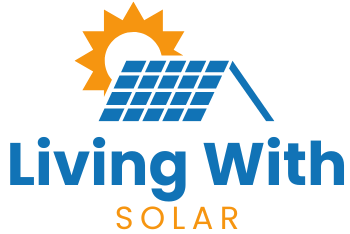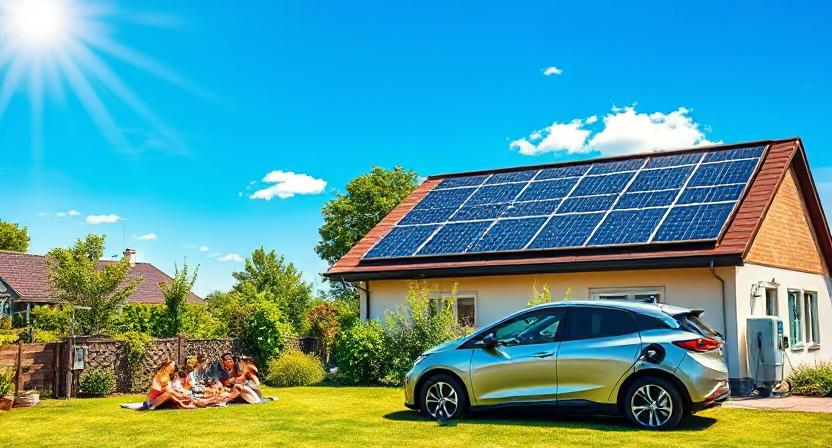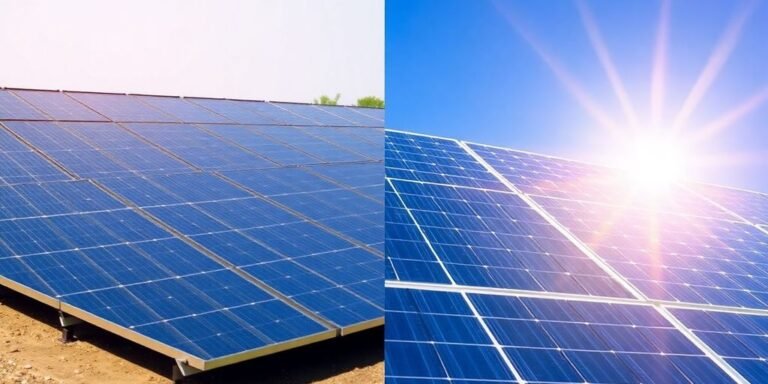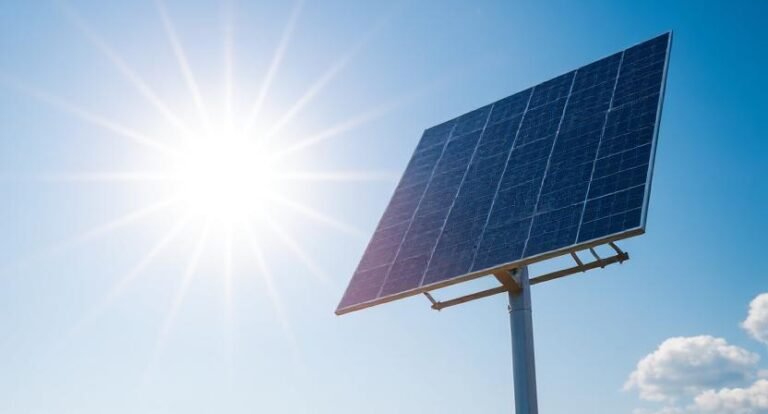Solar energy is a game changer in my everyday life. I use it to power my home, cut down on electricity bills, and enjoy efficient water heating. Solar lights brighten my garden, while portable solar chargers keep my devices powered. I love cooking with solar ovens, and natural heating systems make my living spaces comfortable year-round. With solar-powered vehicles on the rise, there’s even more to explore about how solar is enhancing our lives.
Explore how solar power can reduce operational costs for your business.
🔗 Discover More
Powering Your Home With Solar Electricity
When I decided to explore solar electricity for my home, I was amazed at how much it could lower my reliance on traditional energy sources.
Installing solar panels allowed me to harness solar energy, considerably reducing my electricity bills. As more homeowners adopt solar power, it accounted for 2.8% of the total electricity generation in the U.S. by 2021.
The beauty of solar panels is that they not only generate power for my home but also produce excess electricity, which I can send back to the grid.
Thanks to net metering, I earn credits on my utility bills for that surplus energy. With declining installation costs and minimal maintenance, solar electricity has become a convenient and affordable energy solution for my home.
Efficient Water Heating Solutions
When I think about efficient water heating solutions, I’m impressed by both active and passive solar systems.
Active systems use pumps to guarantee you get hot water on demand, while passive systems are simpler and rely on natural processes.
Plus, if you have a pool, solar heating can make a huge difference in keeping your water warm without breaking the bank.
Active System Advantages
Active solar water heating systems offer a remarkable solution for efficiently heating water in our homes.
These systems utilize mechanical pumps to circulate fluids between solar collectors and storage tanks, ensuring effective heating for domestic use.
They provide immediate warmth or store heated water, perfect for showering and laundry.
| Feature | Benefits | Applications |
|---|---|---|
| Higher Efficiency | Lowers electricity bills | Residential hot water |
| Reduces Reliance on Gas | Supports environmental sustainability | Multi-purpose use |
| Versatile Systems | Suitable for various climates | Year-round hot water |
Passive System Benefits
While active solar water heating systems provide many advantages, passive solar water heating offers a compelling alternative for those looking for efficient and cost-effective solutions. I find passive systems to be particularly appealing for several reasons:
- Natural Circulation: They rely on natural physics, allowing for simple heat transfer without mechanical pumps.
- Eco-Friendly: By reducing reliance on traditional electric or gas water heaters, they contribute to sustainable energy practices.
- Low-Maintenance: With fewer moving parts, these systems require less upkeep compared to active systems.
- Cost Savings: They can considerably lower electricity bills, making them a smart investment for homeowners.
In my experience, passive solar water heating systems are a practical choice for anyone wanting an efficient and eco-friendly option.
Solar Pool Heating
Imagine lounging by a warm, inviting pool on a cool evening, knowing that your swim is powered by the sun. Solar pool heating systems efficiently circulate water through solar collectors, heating it before returning it to the pool.
This setup not only extends my swimming season but also helps to reduce reliance on traditional gas or electric heaters.
With installation costs typically ranging from $2,500 to $4,000, I find the payback periods between 1 to 7 years quite appealing.
Plus, I can enjoy lower energy bills while embracing a sustainable lifestyle. Those solar vacuum tubes are particularly impressive for heating hot tub water, ensuring I stay comfortable, no matter the weather!
Enhancing Outdoor Spaces With Solar Lighting
Enhancing outdoor spaces with solar lighting not only beautifies your environment but also promotes sustainability.
I love how solar lighting systems harness sunlight during the day to power outdoor lights at night. Here are four ways solar lighting can enhance your outdoor areas:
- Landscape lighting: Illuminate gardens and pathways for a charming atmosphere.
- Security lighting: Use motion-sensor solar-powered outdoor lights to boost safety around your home.
- LED technology: Modern solar lights provide bright, efficient illumination while keeping energy consumption low.
- Low installation cost: These eco-friendly options require minimal maintenance and no electrical wiring, making them accessible for everyone.
With solar lighting, I can create a beautiful and sustainable outdoor space that fits my lifestyle.
Portable Solar Charging for Devices
When I head outdoors for an adventure, having a portable solar charger with me makes all the difference. These lightweight and compact devices harness solar energy to charge my smartphone, tablet, or laptop, eliminating the need for traditional outlets.
Many portable solar chargers come with built-in batteries, storing energy for later use, so I can charge devices even when the sun isn’t shining.
They’re perfect for camping, hiking, or any outdoor activities. Plus, using them is a sustainable alternative that helps reduce reliance on fossil fuels and promotes eco-friendly practices. Here’s a quick comparison of some popular models:
| Model | Charge Time (hrs) | Built-in Battery (mAh) |
|---|---|---|
| SolarGo 10W | 3 | 10,000 |
| EcoCharge 15W | 4 | 20,000 |
| SunPower 20W | 2.5 | 15,000 |
| GreenTech 25W | 3.5 | 25,000 |
Innovative Solar Cooking Methods
I’ve been fascinated by the different types of solar ovens, like parabolic and box cookers, that can turn sunlight into a reliable cooking source.

Not only do they offer a way to prepare meals without traditional fuels, but they also come with great benefits for the environment and our wallets.
Plus, they’re perfect for outdoor adventures, making cooking with just sunlight a fun and eco-friendly option.
Types of Solar Ovens
While many people may think of traditional cooking methods, solar ovens offer innovative alternatives that harness the sun’s energy for preparing meals.
I’ve explored several types of solar ovens, each with unique benefits:
- Parabolic Solar Ovens: These use reflective surfaces to focus sunlight, achieving high temperatures perfect for baking and roasting.
- Box Solar Ovens: With insulated walls and a transparent top, they trap heat for slow cooking, making them great for steady temperature meals.
- Panel Solar Cookers: Lightweight and portable, these flat panel cookers reflect sunlight toward a pot, ideal for outdoor cooking.
- Solar Cookers’ Efficiency: They can reach between 200°F to 400°F, cooking without conventional fuels and providing significant environmental benefits as an eco-friendly option.
Benefits of Solar Cooking
Although many people may not realize it, solar cooking offers a multitude of benefits that extend beyond just saving on fuel costs.
By utilizing solar ovens, I can harness renewable energy from the sun, which not only helps me save money but also promotes energy independence.
The various cooking methods, like baking and boiling, allow me to prepare a wide range of meals while being environmentally friendly.
Since solar cooking eliminates the need for conventional fuels, it greatly reduces carbon emissions and lessens our environmental impact.
Additionally, it encourages sustainability by decreasing reliance on firewood, helping to prevent deforestation. Overall, embracing solar cooking is a practical choice for both my wallet and the planet.
Outdoor Cooking Solutions
There’s something truly exciting about outdoor cooking with innovative solar methods. Using solar ovens, like parabolic, box, and panel cookers, I’ve discovered eco-friendly ways to prepare meals without conventional fuels.
These solar cooking devices can reach high temperatures, making them versatile for baking, boiling, or steaming on sunny days.
Plus, they help reduce deforestation by lowering the demand for firewood. Here are some outdoor cooking solutions I’ve tried:
- Parabolic solar ovens – focus sunlight for quick cooking.
- Box cookers – perfect for baking and slow cooking.
- Panel cookers – lightweight and portable for camping.
- Solar stoves – contribute to clean air quality with no emissions.
Embracing solar energy truly enhances my outdoor cooking experiences!
Natural Heating and Cooling Systems
Natural heating and cooling systems offer innovative ways to harness solar energy, making our homes more comfortable and sustainable.
I’ve found that solar heating through solar thermal collectors not only heats water for daily use but also reduces my reliance on traditional gas or electric heaters.
Passive solar heating, with its large windows and thermal mass, naturally keeps my living space cozy without breaking the bank.
In warmer climates, solar chimneys improve ventilation and air quality while cooling my home. Additionally, using solar heating for swimming pools is an excellent investment, often paying off in 1 to 7 years.
By integrating these systems with existing HVAC systems, I enjoy substantial energy savings and contribute to a greener lifestyle.
Sustainable Transportation Solutions
Sustainable transportation solutions are transforming the way we think about getting from point A to point B.
As I explore this exciting field, I see the potential of solar energy solutions playing an essential role. Here are a few key advancements:
- Solar-powered vehicles are becoming more common, with innovations like the first solar aircraft crossing the Pacific.
- Photovoltaic (PV) energy is being integrated into public transit, enhancing sustainability and cutting costs.
- Cities are installing solar charging stations for electric vehicles, promoting clean energy refueling.
- The rise of electric vehicles and hybrids is considerably reducing greenhouse gas emissions.
Solar-Powered Wearable Technology
As I plunge into the world of solar-powered wearable technology, I’m excited by how it’s revolutionizing the way we interact with our devices.

These innovative gadgets use integrated solar cells to convert sunlight into electrical energy, which is a game-changer for outdoor enthusiasts who need reliable power during hikes or camping trips.
The lightweight, flexible solar panels enhance comfort and guarantee that features like GPS tracking and health monitoring are always operational.
Plus, advancements in solar textiles are creating clothing that can charge devices on-the-go, promoting eco-friendly energy use in our everyday lives.
By adopting solar-powered wearables, we contribute to a reduction in battery waste, making it a sustainable choice for powering personal electronics.
Frequently Asked Questions
How Is Solar Energy Used in Our Everyday Lives?
Everyday, I see solar energy in action—like my neighbor’s solar panels powering their home. I love using my portable solar charger for hikes and cooking with a solar oven, making life more sustainable and enjoyable.
How Do You Use Solar Energy on a Daily Basis?
I’ve embraced the sun’s gentle touch in my daily routine. From charging my devices with portable solar chargers to enjoying warm meals cooked under its watchful gaze, it’s been a transformative journey towards sustainability and energy independence.
Where Is Solar Energy Most Commonly Used?
When I think about where solar energy’s most commonly used, I see it everywhere—homes with PV panels, solar water heaters, outdoor lights, and portable chargers. It’s amazing how it’s become part of our daily lives!
Why Is the Solar System Important in Everyday Life?
I believe the solar system’s importance in everyday life lies in its impact on our environment and energy sources. It reminds us of our place in the universe and inspires sustainable practices for a healthier planet.





